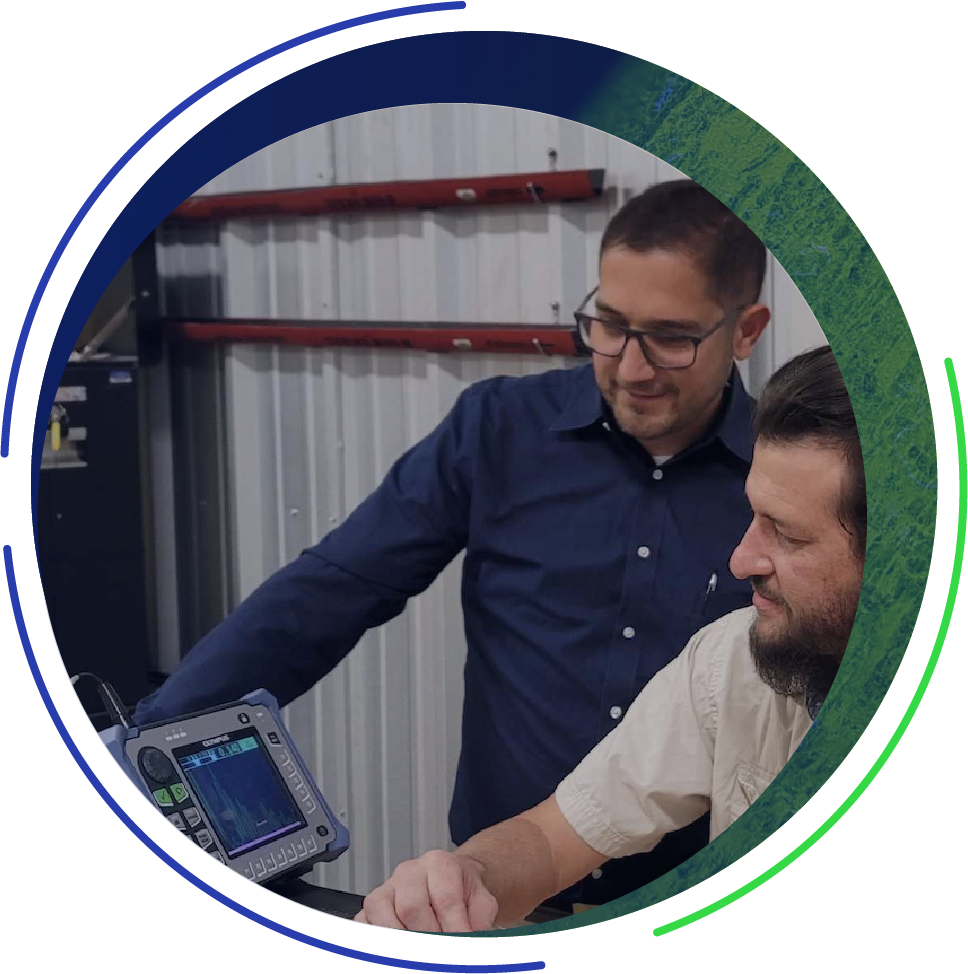Maritime NDT Services
Custom On-Site Services And Program Development
Navy Ships
Navy Vessels are constructed IAW Naval Sea Systems Command (NAVSEA) technical publications. NAVSEA has many technical publications. Depending on the type of ships you’re working on, some of the prominent publications are:
- T9074-AS-GIB-010/271 – Requirements for Nondestructive Testing Methods
- S9074-AQ-GIB-010/248 – Requirements for Welding and Brazing Procedure and Performance Qualification
- S9074-AR-GIB-010/278 – Requirements for Fabrication Welding and Inspection, and Casting Inspection and Repair for Machinery, Piping, and Pressure Vessels
Each of these publications defines the requirements for a specific process, e.g., NDT or welding. Luckily, the folks in the Navy made the title of the publications very self-explanatory!

T9074-AS-GIB-010/271 - Requirements for Nondestructive Testing Methods
T9074-AS-GIB-010/271, or Tech Pub 271 for short, describes all of the requirements for conducting NDT to determine the presence of discontinuities in metals. It also contains the minimum requirements to qualify NDT personnel, procedures, and equipment. Acceptance criteria will not be found in Tech Pub 271 as that will be listed in the applicable fabrication document, such as S9074-AR-GIB-010/278. Tech Pub 271 tells you how to inspect components.
When working to Tech Pub 271, a procedure should be developed that specifically describes how the company will perform inspections. The procedure also has to be qualified prior to use. Qualification of the procedure (which many companies forget to do) requires an inspector to find flaws in a test part that are near the threshold of rejection while inspecting to the procedure. This qualification only needs to be documented and saved in case someone asks for it down the road. Procedures must be submitted to the Navy for approval and can take a lot of time. It is critical to have a complete and thorough procedure before submission!
An essential part of Tech Pub 271 is Chapter 1. Amongst other things, Chapter 1 contains personnel qualification and certification requirements. It requires companies to develop a written practice that meets ASNT SNT-TC-1A as modified by Tech Pub 271. This means that ASNT-TC-1A becomes a minimum requirement! Some of the requirements Tech Pub 271 modifies are a three-year certification interval for inspectors, technical performance evaluations, and recertification by testing for all levels. Yes, that includes Level 3s.
S9074-AQ-GIB-010/248 - Requirements for Welding and Brazing Procedure and Performance Qualification
S9074-AQ-GIB-010/248, or Tech Pub 248 for short, contains the requirements for the qualification of welding and brazing procedures, welders, welding operator, brazers, and brazing operators. The requirements laid out must be met prior to any production fabrication. Tech Pub 248 covers manual, semiautomatic, automatic, and machine welding and brazing of ferrous, nonferrous, and dissimilar metal operations. Tech Pub 248 tells you how to qualify welders and create and qualify welding procedures.
Like NDT procedures, welding procedures must be developed, qualified, and submitted. There is no pre-approved procedure that can be used. A procedure qualification record (PQR) must be created, documented, and submitted with the procedure to the Navy. The PQR consists of making a weld IAW the procedure, then putting that weld through a bunch of nondestructive and destructive testing to ensure it works. A convenience of Tech Pub 248 is that multiple weld procedures may be qualified from 1 PQR test assembly. Careful planning and design of test assemblies are critical to producing an acceptable PQR.
Welders must be qualified by training and testing when working to Tech Pub 248. For welder training qualification, the company must establish a training program that includes:
- A procedure that covers all aspects of training and associated responsibilities
- Administration of training that covers workmanship and visual inspection requirements of applicable fabrication documents
- Examination over that training
- Maintenance of examination records
- Re-examination requirements
- Vision testing
- Program auditing by a Level 3 Examiner
This program must be approved by a Level 3 Examiner (which is someone certified to a Level 3 IAW Tech Pub 271). Every welder must initially and periodically attend the training and pass the testing mentioned above. Take note that this program must also be audited by a Level 3 Examiner yearly!
Welders must also be qualified by testing. Testing consists of welders performing a weld test that goes through destructive, nondestructive, or both testing. This qualification process can become very complicated based on your company’s number of welding procedures. It gets tricky because the performance test isn’t solely based on the procedure; it is based on the base material, filler material, welding process, position, and joint type. This means that a welder could perform one weld test that qualifies them for multiple welding procedures. Careful planning and test assembly design are critical for qualifying welders.
S9074-AR-GIB-010/278 - Requirements for Fabrication Welding and Inspection, and Casting Inspection and Repair for Machinery, Piping, and Pressure Vessels
S9074-AR-GIB-010/278 or Tech Pub 278 contains the welding and allied processes (except brazing) and casting requirements, including inspection for the fabrication, alteration, or repair of any item or component of machinery, piping, and pressure vessels in ships of the United States Navy. It tells you what needs inspecting and what the acceptance criteria are.
If you’ve seen terms like “Class M-2, Category B” and don’t know what they mean, you’re not alone! Check out “Classification” in Section 3 of Tech Pub 278. Each term is defined and explained as what it is.
Tech Pub 278 has stringent quality assurance requirements that often get overlooked. Under Section 4, there are requirements that companies have procedures and forms documenting the responsibility and accountability for work and inspections performed. According to Section 4 of Tech Pub 278, one of the procedures a company should have is for material control. Any incoming material shall have its material test report (MTR) reviewed for compliance with mechanical and chemical requirements to Tech Pub 278 or applicable fabrication document. Furthermore, periodic audits must be performed of the inventory and shop to ensure material traceability is not lost. The procedure should define a system that requires visual verification of materials before fabrication or installation. These are just a few nuances of Tech Pub 278. There are many more forms and procedures that are required to have a complete and robust welding program. Our team can help you precisely navigate what you need.
Commercial Ships
Many of the ships being utilized in the private sector are constructed IAW the American Beuro of Shipping’s (ABS) rules. ABS rules, like NAVESEA, have many publications that apply to different parts of ship building. Similar welding, fabrication, and NDT program must be established and, in many cases, be approved by an ABS Surveyor.
Help?!
Does this sound like a lot? Well, it is! Creating and maintaining a welding, fabrication, and NDT program to NAVSEA or ABS requirements is a lot! Our experts at Premier NDT Resources can do anything from developing the program from scratch with you to modifying or adding to an existing program to auditing a current program. We can help you avoid costly oversights because, well, because we’ve already made and learned from the oversights! Our staff has all graduated from the School of Hard Knocks! Let us save you the headache and get to your end goal faster.
When it comes to your Maritime welding, fabrication, and NDT needs, don’t struggle through it yourself or choose the most convenient consultant; reach out to the professionals! The experts at Premier NDT Resources have real-life experience in the development, implementation, application, and compliance of the most complicated and stringent publications in the maritime industry. We are customer-minded and focus on compliance, safety, and effectiveness. Our team is friendly, adaptable, and able to work with people at all levels. Whether developing a turn-key program or providing a fresh view on a well-established program, we’ve got your back.
Development
Auditing
Services
Services
Development
 Maritime Program Development
Maritime Program Development
Welding, Fabrication, and NDT Program Development and Administration
- Provide Level 3 Examiner oversight of NDT and Welding programs
- Develop, review and approve Written Practices
- Develop, implement, and maintain NDT Program in part or as a whole
- Develop, qualify and approve NDT procedures and techniques
- Perform annual proficiency evaluations
- Maintain overall control and cognizance over the NDT training program
- Develop, administer, review, and approve NDT training
- Develop, administer and grade general, specific, practical, and visual acuity exams required for certification
- Verify qualifications of candidates and recommend them for certification
- Evaluate and document the technical performance of NDT technicians
- Develop and administer the Welder Workmanship program and testing
- Develop welding and fabrication procedures
- Aid in the design, testing, and documentation of Procedure Qualification and Welder Qualification test plates

Auditing
 PROGRAM AUDITING
PROGRAM AUDITING
Maritime Program Auditing
- Administer NAVSEA required program audits
- Perform internal company audits on the quality system, NDT, welding, fabrication, or ITAR programs
- Perform program gap assessments
- Perform pre-audits in preparation for an external audit
- Develop audit checklists
- Audit personnel and processes for compliance and efficiency
- Represent the company during external audits
- Provide suggestions for program/system improvement
- Provide an outside view on program completeness, effectiveness, and applicability

Services
 NDT LEVEL 3 SERVICES
NDT LEVEL 3 SERVICES
Maritime Nondestructive Testing Level 3 Services
- Reviewing new revisions of publications and updating company procedures accordingly
- Interpret publications, and designate NDT methods to be used
- Implement corrective actions from internal or external audits
- Develop or evaluate new or existing inspection techniques
- Develop welding and fabrication procedures
- Aid in the design, testing, and documentation of Procedure Qualification and Welder Qualification test plates

Services
 TRAINING SERVICES
TRAINING SERVICES
Maritime Nondestructive Testing Training
- Administer T9074-AS-GIB-010/271 and SNT-TC-1A compliant NDT training for VT, PT, MT, UT, RT, and ET
- Administer NAVSEA compliant Welder Workmanship training
- Develop and administer Welder Workmanship training exams
- Develop, administer, and grade general, specific, practical, and visual acuity exams required for certification
- Train personnel on providing vision exams

 Maritime Program Development
Maritime Program Development
Welding, Fabrication, and NDT Program Development and Administration
- Provide Level 3 Examiner oversight of NDT and Welding programs
- Develop, review and approve Written Practices
- Develop, implement, and maintain NDT Program in part or as a whole
- Develop, qualify and approve NDT procedures and techniques
- Perform annual proficiency evaluations
- Maintain overall control and cognizance over the NDT training program
- Develop, administer, review, and approve NDT training
- Develop, administer and grade general, specific, practical, and visual acuity exams required for certification
- Verify qualifications of candidates and recommend them for certification
- Evaluate and document the technical performance of NDT technicians
- Develop and administer the Welder Workmanship program and testing
- Develop welding and fabrication procedures
- Aid in the design, testing, and documentation of Procedure Qualification and Welder Qualification test plates

 PROGRAM AUDITING
PROGRAM AUDITING
Maritime Program Auditing
- Administer NAVSEA required program audits
- Perform internal company audits on the quality system, NDT, welding, fabrication, or ITAR programs
- Perform program gap assessments
- Perform pre-audits in preparation for an external audit
- Develop audit checklists
- Audit personnel and processes for compliance and efficiency
- Represent the company during external audits
- Provide suggestions for program/system improvement
- Provide an outside view on program completeness, effectiveness, and applicability

 NDT LEVEL 3 SERVICES
NDT LEVEL 3 SERVICES
Maritime Nondestructive Testing Level 3 Services
- Reviewing new revisions of publications and updating company procedures accordingly
- Interpret publications, and designate NDT methods to be used
- Implement corrective actions from internal or external audits
- Develop or evaluate new or existing inspection techniques
- Develop welding and fabrication procedures
- Aid in the design, testing, and documentation of Procedure Qualification and Welder Qualification test plates

 TRAINING SERVICES
TRAINING SERVICES
Maritime Nondestructive Testing Training
- Administer T9074-AS-GIB-010/271 and SNT-TC-1A compliant NDT training for VT, PT, MT, UT, RT, and ET
- Administer NAVSEA compliant Welder Workmanship training
- Develop and administer Welder Workmanship training exams
- Develop, administer, and grade general, specific, practical, and visual acuity exams required for certification
- Train personnel on providing vision exams

Premier NDT RESOURCES Dedicated Service Team
Our team will respond within 24-hours

